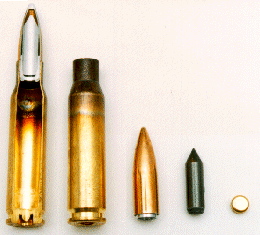Ballistic data for 7.62mm ammunition.
| Model |
Cartridge Weight |
Cartridge Length |
Propellant |
Projectile Weight |
Chamber Pressure |
Velocity
78 ft (23.8 m) from muzzle |
| M59 Ball |
393 gr (25.47 g) |
2.8 in (71.1 mm) |
WC 846 |
150.5 gr (9.75 g) |
50,000 psi (3,515 kg/cm²) |
2,750 fps (838 mps) |
| M60 HPT |
412 gr (26.7 g) |
2.8 in (71.1 mm) |
IMR 4475 |
171.5 gr (11.11 g) |
67,500 psi (4,745 kg/cm²) |
N/A |
| M61 AP |
393 gr (25.47 g) |
2.8 in (71.1 mm) |
IMR 4475 |
150.5 gr (9.75 g) |
50,000 psi (3,515 kg/cm²) |
2,750 fps (838 mps) |
| M62 Tracer |
383 gr (24.81 g) |
2.8 in (71.1 mm) |
WC 846 |
142 gr (9.2 g) |
50,000 psi (3,515 kg/cm²) |
2,750 fps (838 mps) |
| M62 Tracer OFM |
387 gr (25.08 g) |
2.8 in (71.1 mm) |
WC 846 |
146 gr (9.46 g) |
50,000 psi (3,515 kg/cm²) |
2,750 fps (838 mps) |
| M63 Dummy |
258 gr (16.72 g) |
2.8 in (71.1 mm) |
N/A |
? |
N/A |
N/A |
| M64 Grenade |
295 gr (19.12 g) |
2 in (50.8 mm) |
WC 830 |
N/A |
N/A |
160 fps (49 mps) 5.5 ft (1.7 m) from muzzle, projected grenade |
| M80 Ball |
392 gr (25.4 g) |
2.8 in (71.1 mm) |
WC 846 |
146 gr (9.46 g) |
50,000 psi (3,515 kg/cm²) |
2,750 fps (838 mps) |
| M82 Blank |
235 gr (15.23 g) |
2.6 in (66.04 mm) |
SR 8231 |
N/A |
N/A |
N/A |
| M118 Special Ball |
390 gr (25.27 g) |
2.83 in (71.88 mm) |
WC 846 or IMR 4895 |
172 gr (11.15 g) |
50,000 psi (3,515 kg/cm²) |
2,640 fps (805 mps) |
| M160 Frangible |
315 gr (20.41 g) |
2.8 in (71.1 mm) |
SR 8074 |
108.5 gr (7.03 g) |
N/A |
1,320 fps (402 mps) 100 yd (91 m) from muzzle |
| M172 Dummy |
385 gr (24.95 g) |
2.8 in (71.1 mm) |
N/A |
? |
N/A |
N/A |
| M276 Dim Tracer |
381 gr (24.69 g) |
2.8 in (71.1 mm) |
WC 846 |
140-150 gr (9.07-9.72 g) |
50,000 psi (3,515 kg/cm²) |
2,750 fps (838 mps) GMCS
2,680 fps (817 mps) GM |
| M852 Match |
385 gr (24.95 g) |
2.83 in (71.88 mm) |
IMR 4895 |
168 gr (10.89 g) Hollow point |
50,000 psi (3,515 kg/cm²) |
2,550 fps (777 mps) |
| M993 AP |
362.6 gr (23.5 g) |
2.8 in (71.1 mm) |
Bofors NC1290 |
126.6 gr (8.2 g) |
55,115 psi (3,875 kg/cm²) |
2,985 fps (910 mps) |
Cartridge, 7.62mm, Ball, M59

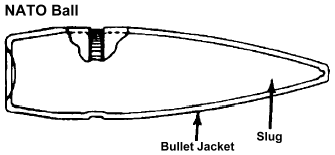
The cartridge is used in the M60 and M219 machine guns, and the M14 rifle. The cartridge is intended for use
against personnel and unarmored targets.
Contains a soft steel core. The cartridge is identified by a plain bullet tip.
Type Classification: STD - OTCM 36841
Cartridge, 7.62mm, High Pressure Test, M60

Used by all 7.62mm weapons. The cartridge is not for field issue, but is used for proof firing of weapons during
manufacture, test, or repair.
The cartridge is identified by a stannic-stained (silvered) case.
Type Classification: OBS - MSR 11756003
Cartridge, 7.62mm, Armor Piercing, M61

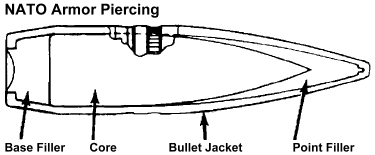
Used by M60, M219, and M240 machine guns, and the M14 rifle. The cartridge is used in rifles and machine guns against personnel
and light armored or unarmored targets, concrete shelters, and similar bullet-resisting targets.
Armor Penetration.
300 meters: 0.28 in (7 mm)
500 meters: 0.2 in (5 mm)
The cartridge is identified by a black bullet tip.
This ammunition is not authorized for training purposes.
Type Classification: OBS - MSR 11756003
Cartridge, 7.62mm, Tracer, M62

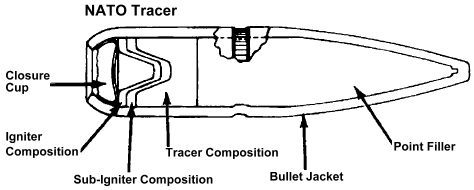
Used by M60, M219, and M240 machine guns, and the M14 rifle. For observation of fire, incendiary effects, signaling, and for
training. When tracer rounds are fired in machine guns, they are mixed with ball ammunition in a ratio of four ball rounds to one
tracer round.
R284 tracer. The cartridge is identified by an orange bullet tip.
Type Classification: CON - MSR 11756003
Cartridge, 7.62mm, Tracer, M62 (Overhead Fire Application)
Used by M60, M219, and M240 machine guns, and the M14 rifle. The cartridge is used in weapons for firing over the heads of troops
being trained in field exercises. Stringent production control and screening of ammunition lots ensure the safety of personnel
operating immediately below the trajectory of the fired bullets.
R284 tracer. The cartridge is identified by a red bullet tip.
Type Classification: CON - MSR 11756003
Cartridge, 7.62mm, Dummy, M63

Used by M60, M219, and M240 machine guns, and the M14 rifle. The cartridge is used for practice in loading 7.62mm weapons for
simulated firing to detect flinching of personnel during firing and for inspecting and testing the weapon mechanism.
There are six longitudinal corrugations (flutings) on the cartridge. Also, there is no primer or vent hole in the primer pocket.
Type Classification: STD - OTCM 36841
Cartridge, 7.62mm, Grenade, M64
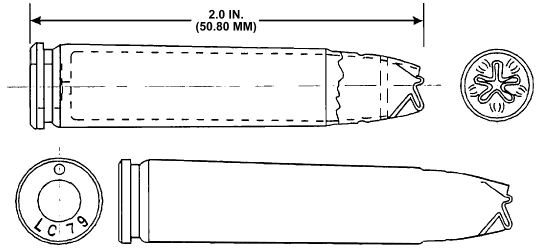
Used by the M14 rifle. The cartridge provides pressure upon functioning to project rifle grenade to a desired target when using a
grenade projectile adapter.
The cartridge is identified by a rose-petal (rosette-crimp) closure of the cartridge case mouth and sealed with red lacquer.
Type Classification: OBS - MSR 11756003
Cartridge, 7.62mm, Ball, M80
Used by M60, M219 and M240 machine guns, and the M14 rifle. For use against light materials and personnel, and for range training.
The bullet consists of a gilding-metal steel jacket with a lead-antimony slug. The cartridge case is brass and the bullet is unpainted.
Armor Penetration.
300 meters: 0.16 in (4 mm)
500 meters: 0.12 in (3 mm)
This is a training standard item used for both training and combat.
Type Classification: STD - MSR 07798001. Type Classification Date: 1979.
Unit cost: $0.51 (Fiscal Year 2005).
Cartridge, 7.62mm, Ball, M80 (Overhead Fire Application)
Used by M60, M219 and M240 machine guns. The cartridge is used in machine guns for firing over the heads of troops being trained
in field exercises. Stringent production control and screening of ammunition lots ensure the safety of personnel operating
immediately below the trajectory of the fired bullets.
The cartridge is identified by a plain bullet tip.
Type Classification: STD - MSR 07798001.
Cartridge, 7.62mm, Blank, M82
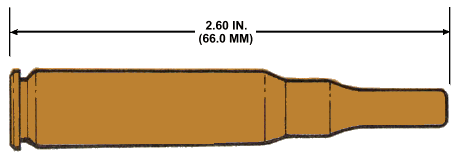
Used by M60, M219 and M240 machine guns, and the M14 rifle. For use during training when simulated live fire is desired.
A blank firing attachment (BFA) should be used to fire this ammunition.
This cartridge consists of a primer and propellant contained in a brass case shaped to conform to the configuration of the service
round. The propellant is held in by a wad. The mouth of the cartridge is sealed and crimped.
Type Classification: STD - OTCM 36841. Type Classification Date: 1958.
Unit cost: $0.26 (Fiscal Year 2005).
Cartridge, 7.62mm, Ball, Special, M118
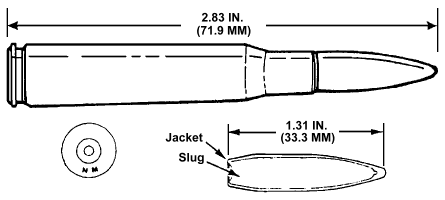
Used by the M14 rifle, and the M21, M24, and M40A1 sniper rifles. The cartridge is intended and specifically prepared for use
in high accuracy weapons. Its spread (accuracy standard) for a 10-shot group is no more than 12 inches (305 mm) at 600 yards (550 m)
- fired from an accuracy barrel in a test cradle.
The bullet consists of a gilding metal jacket and a lead antimony slug. It is a boat-tailed bullet (rear of bullet is tapered). The
tip of the bullet is not colored. The cartridge is identified by cartridge case head stampings with NATO design mark, manufacturer and year.
Type Classification: STD - MSR 07798001
Unit cost: $0.53 (Fiscal Year 2005).
Cartridge, 7.62mm, Frangible, M160

Used by M219 and M240 machine guns. The cartridge is designed for firing single shots in the machine gun for gunnery practice.
The frangible bullet, upon striking a target, disintegrates, leaving a mark at the point of impact.
The cartridge is identified by a green bullet tip with a white ring to the rear of the green tip.
Type Classification: STD - AMCTC 2186
Cartridge, 7.62mm, Dummy, M172
The cartridge is inert and is used to test the mechanism and metallic link belts of 7.62mm weapons.
The cartridge is identified by a black oxide finish over the entire round and has no primer. There is no vent hole in the
primer pocket.
Type Classification: STD - AMCTC 4635
Cartridge, 7.62mm, Dim Tracer, M276
Used by M60, M134, M219, and M240 machine guns, and the M14 rifle. The combat cartridge is to be used by soldiers equipped with
night vision equipment.
R440 trace mix. The cartridge is identified by a pink ring behind a green tip.
Cartridge, 7.62mm, Match, M852

Used by National Match M14 Rifle. The cartridge is intended and specifically prepared for use in
those weapons designated as competitive rifles and also for marksmanship training. The cartridge is not for combat use.
The cartridge is identified by the cartridge case head stamping of MATCH. It also has a knurl at the base of the cartridge case and
a hollow point bullet.
Type Classification: STD - MSR 09816009
Cartridge, 7.62mm, Armor Piercing, M993
Used by M60 and M240 machine guns, and the M24 Sniper Weapon System. Intended for use against current and future light armored
targets. The M993 offers the capability to defeat these targets at ranges 2 to 3 times that of previous AP ammunition.
The projectile assembly consists of a tungsten core penetrator contained in an aluminum cup and jacketed by tombac (similar to standard
gilding metal, 90% copper, 10% zinc) clad steel. The shaped tungsten core provides enhanced armor penetration, representing a key
departure from the current 7.62mm ball service round. The Bofors CGAB produced cartridge utilizes a conventional brass cartridge case
with a Berdan primer. The propellant is a single base type manufactured by Bofors and the primer is manufactured by Dynamit Noble.
The M993 7.62mm AP Round is capable of penetrating a 7mm thick high hardness armor (HHA) plate at a distance
of 500 meters from the muzzle of the weapon. This corresponds to 1/4" armor plate at a distance of 550m.
Type Classification Date: 16 FEB 1996.
Unit cost: $2.61 (Fiscal Year 2005).
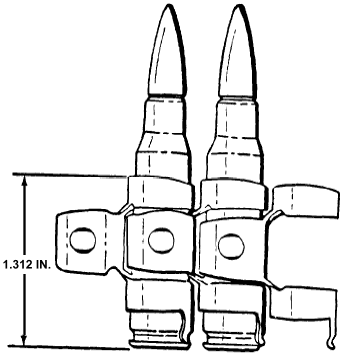



 Used by all 7.62mm weapons. The cartridge is not for field issue, but is used for proof firing of weapons during
manufacture, test, or repair.
Used by all 7.62mm weapons. The cartridge is not for field issue, but is used for proof firing of weapons during
manufacture, test, or repair.

 Used by M60, M219, and M240 machine guns, and the M14 rifle. The cartridge is used in rifles and machine guns against personnel
and light armored or unarmored targets, concrete shelters, and similar bullet-resisting targets.
Used by M60, M219, and M240 machine guns, and the M14 rifle. The cartridge is used in rifles and machine guns against personnel
and light armored or unarmored targets, concrete shelters, and similar bullet-resisting targets.

 Used by M60, M219, and M240 machine guns, and the M14 rifle. For observation of fire, incendiary effects, signaling, and for
training. When tracer rounds are fired in machine guns, they are mixed with ball ammunition in a ratio of four ball rounds to one
tracer round.
Used by M60, M219, and M240 machine guns, and the M14 rifle. For observation of fire, incendiary effects, signaling, and for
training. When tracer rounds are fired in machine guns, they are mixed with ball ammunition in a ratio of four ball rounds to one
tracer round.
 Used by M60, M219, and M240 machine guns, and the M14 rifle. The cartridge is used for practice in loading 7.62mm weapons for
simulated firing to detect flinching of personnel during firing and for inspecting and testing the weapon mechanism.
Used by M60, M219, and M240 machine guns, and the M14 rifle. The cartridge is used for practice in loading 7.62mm weapons for
simulated firing to detect flinching of personnel during firing and for inspecting and testing the weapon mechanism.
 Used by the M14 rifle. The cartridge provides pressure upon functioning to project rifle grenade to a desired target when using a
grenade projectile adapter.
Used by the M14 rifle. The cartridge provides pressure upon functioning to project rifle grenade to a desired target when using a
grenade projectile adapter.

 Used by the M14 rifle, and the M21, M24, and M40A1 sniper rifles. The cartridge is intended and specifically prepared for use
in high accuracy weapons. Its spread (accuracy standard) for a 10-shot group is no more than 12 inches (305 mm) at 600 yards (550 m)
- fired from an accuracy barrel in a test cradle.
Used by the M14 rifle, and the M21, M24, and M40A1 sniper rifles. The cartridge is intended and specifically prepared for use
in high accuracy weapons. Its spread (accuracy standard) for a 10-shot group is no more than 12 inches (305 mm) at 600 yards (550 m)
- fired from an accuracy barrel in a test cradle.
 Used by M219 and M240 machine guns. The cartridge is designed for firing single shots in the machine gun for gunnery practice.
The frangible bullet, upon striking a target, disintegrates, leaving a mark at the point of impact.
Used by M219 and M240 machine guns. The cartridge is designed for firing single shots in the machine gun for gunnery practice.
The frangible bullet, upon striking a target, disintegrates, leaving a mark at the point of impact.
 Used by National Match M14 Rifle. The cartridge is intended and specifically prepared for use in
those weapons designated as competitive rifles and also for marksmanship training. The cartridge is not for combat use.
Used by National Match M14 Rifle. The cartridge is intended and specifically prepared for use in
those weapons designated as competitive rifles and also for marksmanship training. The cartridge is not for combat use.
